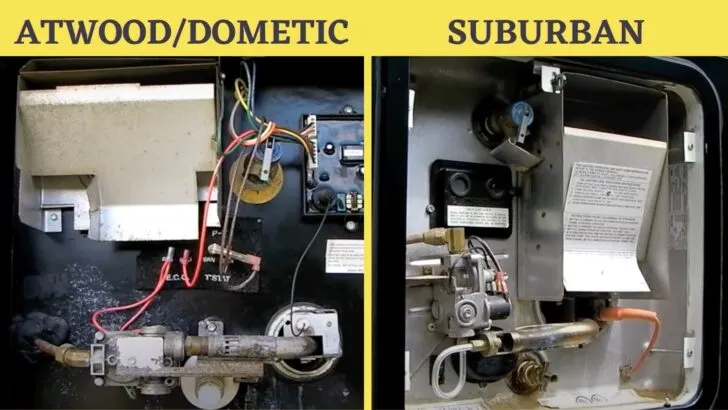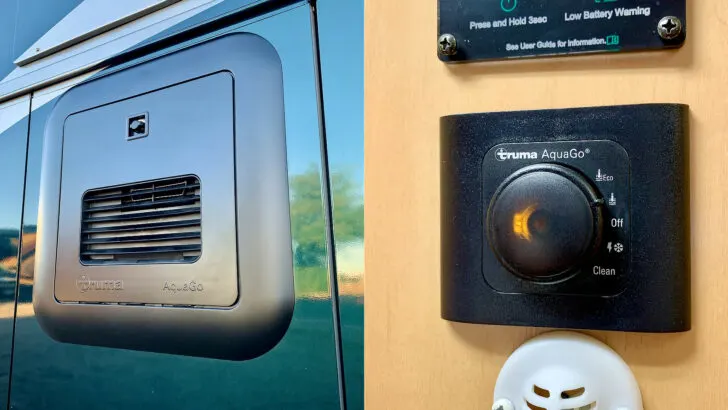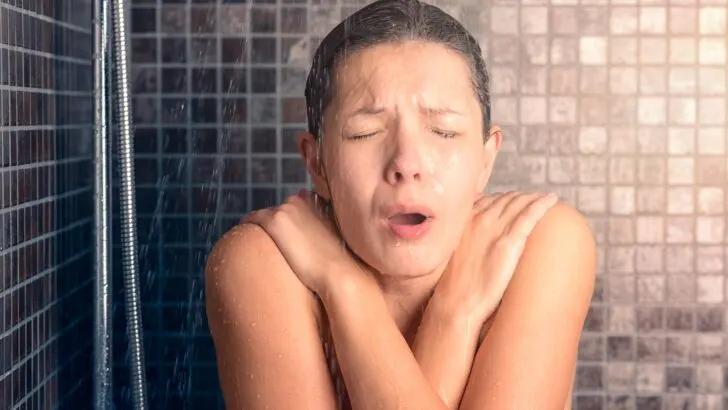These days RVers are hearing a lot about RV tankless water heaters, and with good reason. There are a lot of benefits to tankless heaters. But if you’re trying to decide between an RV tankless water heater vs traditional RV water heater, there are several considerations you’ll want to keep in mind.
In today’s post, we’re looking at the pros and cons of RV tankless water heaters vs tanked models.
- 1) What Is a Traditional RV Water Heater?
- 2) What Is an RV Tankless Water Heater?
- 3) RV Water Heaters: Tank vs Tankless
- 4) Cons of Tankless RV Water Heaters vs Traditional Tank-Style Models
- 5) Traditional or Tankless RV Water Heater: Which Is Better for RVs?
- 6) Free RVing Tips, Tricks, Reviews & Giveaways
What Is a Traditional RV Water Heater?
A traditional or standard water heater in an RV has a tank – most often a 6 to 10-gallon reservoir in which water is stored (though there are larger units, too). They typically heat water with either propane or 120V AC electric power.
The heating process begins when you turn on the switch to heat the water. In about 20-60 minutes (depending on the model and heating method – propane vs electric), the cold water that’s been sitting in the tank is heated, and you’ve got 6 to 10 gallons of hot water.
So, traditional RV hot water heaters warm up the tank of water, and then you can use that to take as many showers as you can get from that volume of water. And unless you wait 20-60 minutes for the tanked water to be heated, you’re taking cold showers.

The two most common brands of traditional/standard RV water heaters have long been from Atwood/Dometic and Suburban. Inside is a tank (usually 6-10 gallons) that holds the water to be heated. And don’t forget that they aren’t “hot water heaters” but rather “cold water heaters!” 😉
What Is an RV Tankless Water Heater?
Tankless RV water heaters (sometimes referred to as “on-demand water heaters”) don’t store water – there’s usually no tank or reservoir at all. When you “demand” hot water by turning on a faucet, water runs from either your fresh water tank (if you’re boondocking) or from your city water source (if you’re hooked up) through the water heater and is instantly heated as the water is flowing. So, tankless water heaters heat water as it flows – on demand.
This means that the only limitation to how much hot water you can get is how much water you can access… and how much propane you have.
So, if you’re boondocking, you’re likely to place some limitations on yourself so that you don’t drain your fresh water tank or overfill your gray tank. But if you’re connected to a city water source and a sewer connection at a campground or RV park with full hookups, you’ll be able to use a virtually endless supply of hot water.
So, if you have a tankless unit you won’t run out of hot water… unless you run out of water. Instant hot water is a real luxury if you love taking long hot showers once in a while.

This is the Truma AquaGo we had installed in our Newmar Mountain Aire to replace a traditional/standard water heater. This split-screen photo shows what the unit looks like from outside the motorhome (left) and what the controls look like inside the rig.
RV Water Heaters: Tank vs Tankless
Let’s take a look at both the pros and cons of tankless RV water heaters when compared with traditional RV water heaters. The following are key advantages of RV tankless water heaters vs traditional (tanked) heaters:
Unlimited Hot Water
Due to how tankless water heaters work, you have a virtually unlimited hot water supply when using a tankless RV water heater. Since they heat water continuously on demand as it’s needed, they just keep making more hot water as long as you keep using it. The main limit is when you’re boondocking, as a full gray tank is a full gray tank, regardless of the temperature of the water in it!
Besides fresh water and gray tank limits when not hooked up to utilities, the only other limit is propane. But tankless water heaters don’t use so much propane that this is likely to be much of an issue. If you have even a modest amount of propane on board, you can take a long, loooooong shower with a tankless RV water heater. And endless hot water is quite a luxury if you’re used to only having 6 to 10 gallons available.
Faster Access to Hot Water
You also have access to hot water much faster because there’s no need to wait for a tank full of water to heat up. The usual 20- to 60-minute wait is non-existent since water is heated on-demand whenever you want it. No preheating is required. If you decide to take a shower on the spur of the moment, just do it!
Less Weight
Tankless water heaters weigh less because there’s no tank full of water to carry, (and water weighs a little over 8 lbs per gallon). And also because they are smaller and lighter than most traditional water heaters. That’s especially true if you have/had a larger model. Our 12-gallon Suburban heater was huge compared to our new Truma on-demand RV water heater.
More Efficient
Tankless heaters are more efficient because less fuel is used since you’re not heating up a tank full of water and keeping it heated. It only has to heat the water you actually need vs the waste of heating an entire tank of water if only a small amount is needed. In the case of our Truma, leaving it in “Eco” mode uses no propane at all until a faucet is turned on (more on Truma’s “Comfort” mode below).
Also, “standby loss” occurs when you have to reheat the water in the tank that was already heated… but cooled down, and now needs to be heated back up. Tankless water heaters eliminate standby loss, making them more efficient than traditional/standard water heaters.
Some tankless water heaters are more efficient than others. It’s always a good idea to look for Energy Star certification.
Adjustable Water Temperature
Some makes/models of tankless heaters have adjustable water temperature output. Note that this isn’t a feature on every tankless model, so if this feature is important to you, look for a unit that offers it.
Traditional RV water heaters use a set-temperature thermostat that keeps the water at one set level and can’t be adjusted.
Cons of Tankless RV Water Heaters vs Traditional Tank-Style Models
While there are lots of benefits to RV tankless water heaters, there are also some disadvantages compared to traditional RV water heaters.
More Complicated/Complex
Tankless units tend to be more complex in design. Tanked water heaters are pretty simple and straightforward — a tank of water that gets heated by an electric element or a flame (electric mode or propane mode, respectively).
Tankless units have to be able to measure water flow and are designed to warm the water as it moves through it. The brains that control tankless water heaters are also more complex than typical tanks full of water. There are unlikely to be many user-serviceable parts in them.
Requires a Higher Water Flow Rate to Stay Hot
Typically measured in gallons per minute (GPM), flow rate is the volume of water that moves through the heater. The potential problem is that a minimum flow rate is required to trigger the heating cycle/process in a tankless heater. This results in more water use, which can be problematic when boondocking and trying to conserve water.
Traditional RV water heaters have no minimum flow rate, since (once the hot water has been run up), even the tiniest trickle of water will stay hot. But that’s not true with on-demand RV water heaters, which again do have flow-rate minimums to operate.
The lower the GPM that is required to trigger the unit to heat water, the better. That’s because practiced boondockers like us can shower in a very low-flow stream of water. The trickle we use to shower comes in at about 1/3 of a gallon per minute.
That means that a tankless water heater unable to make hot water at that low flow would leave us either taking a cold shower or using a higher flow rate to keep the water heating. That first option is never a good one, and the second isn’t boondocking-friendly.
But there’s more:
For some on-demand water heaters, there can be noticeable temperature swings when the flow rate drops below the required minimum for the unit to heat. Many water heater manufacturers don’t even tell you this, making it difficult to compare units. Not only can this result in aggravating cold showers, but it can also waste a lot of water.

No RVer wants to take a stressful shower that requires high water flow to avoid fluctuating temperatures.
For example, the Black Series off-road camper we were in for a month last year came with a Fogatti brand tankless water heater that required a fairly high flow rate to activate.
As a result, we had to run the water at a higher flow than we’d prefer, using more fresh water, and filling the gray tank faster. In addition, each time we turned the water off (which we of course do frequently when taking Navy showers while boondocking), we had to be sure to step out of the water when we turned it back on to avoid a cold blast while the unit was firing back up. Yup… more wasted water.
More Expensive
Unit and installation costs are often higher for aftermarket replacements with tankless water heaters. That’s partly due to the policies an on-demand water heater manufacturer may follow. We really love our Truma (more on that below), but despite the fact that we’re pretty handy, Truma does not sell their units for DIY self-installation.
That required cost of professional installation of course increases the cost. That may not be an issue for many people (those who would hire a pro to install any replacement RV water heater). But us DIY types are left with a higher cost than we might otherwise incur. But Truma’s dedication to making sure that every unit is correctly installed has merit, too.
On-Demand RV Water Heaters Only Run Off Propane, Not Electricity
And finally, RV tankless water heaters only run off of propane, so you can’t simply rely on 120V AC when at a full hook-up campsite. When paying by the night, electricity is virtually always included. This does sometimes feel like a bit of a missed opportunity — using propane we’ve paid for vs electricity that’s included. (We’re not aware of any electric tankless water heater.)
That said, propane usage on a tankless RV water heater is generally so low that we’ve never found it to be much of an issue or worth worrying about. Our Truma absolutely sips propane, and its benefits are so great, we’re fine with using propane 100% of the time. That’s especially true because we boondock so much, which means we’d be heating water with propane no matter what.
Traditional or Tankless RV Water Heater: Which Is Better for RVs?
In addition to the pros and cons listed above, you’ll want to consider the following when determining which type of RV water heater is better for you.
Your Style of RVing
If you usually camp at full hookups, a tankless water heater will give you gloriously long, hot showers. But if you’re an avid boondocker like us, it could waste water and fill your gray tank faster (depending on the brand/model heater you choose).
The Make/Model of the Tankless Water Heater
Not all tankless water heaters are created equal. They have different minimum water flow levels required to trigger the heating process.
For example:
The Fogatti we mentioned above required about a 1-gallon-per-minute flow to begin heating. As we mentioned, we can easily shower with a flow rate of 1/3 GPM, so it’s obviously sub-optimal for boondocking to have to triple the water flow to take a hot shower.
On the other hand…
The Truma AquaGo Comfort we had installed in our Newmar Mountain Aire claims a minimum of 0.33-gallon-per-minute flow, which would be great if true. But we tested it ourselves, and it worked fine down to 0.25 GPM! How many products exceed the manufacturer’s claims?!
That low flow rate means we can take a nice hot shower at our usual 1/3 GPM rate with no compromises. We LOVE using the Truma AquaGo, which is far superior to any tanked model we’ve ever seen. It’s also far easier to clean and winterize.
One final note about our TrumaGo water heater — while it is on-demand, it isn’t technically tankless. That’s because it does contain a small water tank. Comfort mode uses that tank to store a small amount of very hot water, which is then mixed with cooler water when called for.
That allows hot water to reach the faucets more quickly than when using Eco mode because that small amount of hot water is always standing by. As a result, we follow what seems like a counterintuitive practice — using Comfort mode when boondocking, and Eco mode when hooked up.
Comfort mode requires running up less water (great for boondocking). Eco mode saves propane by using NO propane unless hot water is needed at that moment. But that does mean having to run the water a little longer to get hot water up to the shower (not a problem at a full hookup). For more details, see our guide to RV water heaters.
And if you already have a tankless water heater, but are having troubles, check out our post, “RV Tankless Water Heater Problems Troubleshooting Guide.”
Free RVing Tips, Tricks, Reviews & Giveaways
As 20-year full-timers, we share everything we’ve learned about RVing over the years. Join our online community to receive a wealth of great RVing knowledge delivered daily to your inbox.
Whether you’re a new RVer or a seasoned full-timer, you’ll love the wide range of RVing topics we cover. Don’t miss a single article or any of our famous Giveaways. Subscribe to our newsletter today!


Chris
Tuesday 24th of October 2023
I have a Tiffin allegro bay 38BB all electric coach that has a Truma hot water on demand tank, so I’m not sure where you got your information about it only running off propane
TheRVgeeks
Tuesday 24th of October 2023
We own a Truma AquaGo and it only runs on propane. If you have a Truma unit that also uses electricity, it’s obviously a different model.
keith
Saturday 21st of October 2023
One thing I'd like to clarify; with the 5 or 10 gallon tank systems, you still typically use only a trickle of hot water because the water in the tank is quite hot. So while you may only have 5 gallons of hot water before the propane or electric kicks on, that doesn't mean you only have a minute or two of hot water. My wife and I can both take a proper Navy shower without running out of hot water.
Scott
Friday 20th of October 2023
What is your take on the calcification potential in the tankless systems?
TheRVgeeks
Tuesday 24th of October 2023
That's a good question, Scott. We used ours quite extensively in the desert southwest (we're big snowbirds, LOL!), and never had a problem. We can't speak for the other brands like Girard, Suburban, etc... but on the Truma, the descaling process was super simple. It flashes the control light to let you know when it's needed. Then you follow the instructions, which involve flipping down a panel, removing a filter chamber, putting the decalcification tablets in that chamber, closing it back up, and triggering a clean cycle. When it's done, it's simple to flush the descaler out and get back to normal.
Bones
Friday 20th of October 2023
There certainly are electric tankless water heaters, they do require some hefty wiring and work best on 220 but for very low flow applications can work on 110 30 amp service
TheRVgeeks
Tuesday 24th of October 2023
Yes... but not very practical for an RV that's not connected to the grid. 😉
Jack Price
Friday 20th of October 2023
Just finished installing our 2nd Girard Tankless Water Heater. 1st one was in our 2005 TrailVision Hybrid to replace our frozen Suburban. The best investment ever made for our TT. Traded in 2019 to a Rockwood 2509s and could not live without our Girard. CS is superior, and we had no problems installing. We camp usually in full service RV Parks, and water pressure has never been a problem. Our old model, water temp was changed with a dial under the sink the newer units have a digital thermostat, water temps at the faucet can be mixed, the older units to heat the water you increased the flow of the hot water, and it got hotter... Excellent unit. Highly recommend even though you didn't mention the Girard, it was one of the pioneers units for RV applications... Excellent article and information on the differences... Enjoy your articles...